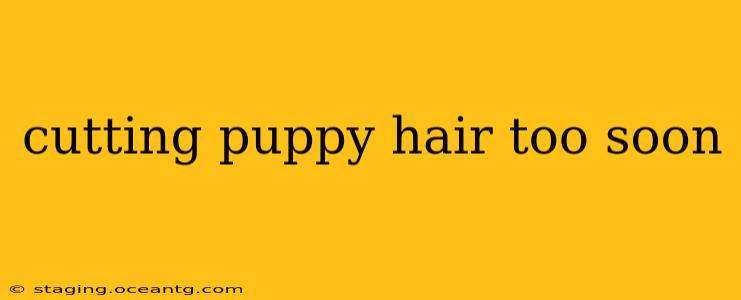Cutting your puppy's hair might seem like a good idea – for aesthetics, for easier cleaning, or even to help with shedding. However, rushing this decision can have serious consequences for your furry friend's health and well-being. This guide explores the potential risks of cutting puppy hair too soon, offers recommendations on when it's appropriate, and provides crucial insights into proper grooming practices.
What are the Risks of Cutting Puppy Hair Too Soon?
Prematurely cutting your puppy's hair can expose them to several risks:
-
Skin Irritation and Infection: A puppy's skin is delicate and sensitive. Improper clipping can cause nicks, cuts, and abrasions, making them susceptible to infection. This is especially true if the clippers aren't properly sanitized.
-
Sunburn: A puppy's coat offers natural sun protection. Removing it before they're ready can leave their skin vulnerable to sunburn, which can be painful and even lead to skin cancer in the long run.
-
Temperature Regulation Issues: A puppy's coat plays a vital role in regulating their body temperature. Removing it prematurely can leave them susceptible to hypothermia in colder climates or overheating in warm weather.
-
Psychological Impact: The grooming experience can be stressful for a young puppy. A bad first experience can create fear and anxiety around future grooming appointments, making it harder to maintain their coat health.
When is the Right Time to Cut My Puppy's Hair?
There's no single answer to this question as it depends on your puppy's breed, coat type, and overall health. However, it's generally recommended to wait until your puppy is at least four months old before considering a professional haircut. Some breeds with longer coats might benefit from trimming specific areas (like around the eyes and paws) earlier, but even then, it's best to consult a professional groomer.
How Do I Know if My Puppy Needs a Haircut?
Instead of focusing on a specific age, consider these factors:
-
Matted Fur: If your puppy's fur is matted, it's crucial to have it addressed by a professional groomer. Matted fur can pull on the skin, causing discomfort and irritation.
-
Excessive Shedding: Excessive shedding can indicate underlying health issues. A professional groomer can help determine the cause and recommend appropriate solutions.
-
Breed-Specific Needs: Certain breeds require regular grooming to prevent matting or skin problems. Research your puppy's breed to understand their specific grooming needs.
What Should I Do if My Puppy Has a Medical Condition Affecting Their Coat?
If your puppy has a medical condition that's affecting their coat, such as allergies or skin infections, you should consult your veterinarian before making any decisions about grooming. Your vet can recommend appropriate treatments and advise on suitable grooming techniques.
Can I Cut My Puppy's Hair Myself?
While it might seem tempting to save money by cutting your puppy's hair yourself, it's generally not recommended, especially for first-time puppy owners. Improper clipping can easily lead to injuries and stress for your puppy. Instead, invest in a professional groomer who has the experience and skills to safely and effectively groom your pet.
How Often Should I Groom My Puppy?
Regular brushing is essential, even if your puppy doesn't need a haircut. Daily brushing helps prevent matting, removes loose fur, and stimulates healthy skin and coat. The frequency of professional grooming will depend on your puppy's breed and coat type.
By understanding the risks associated with cutting your puppy's hair too soon and prioritizing professional grooming when necessary, you'll ensure your puppy remains healthy, happy, and comfortable. Remember, patience is key, and a little wait can make a big difference in your puppy's well-being.
